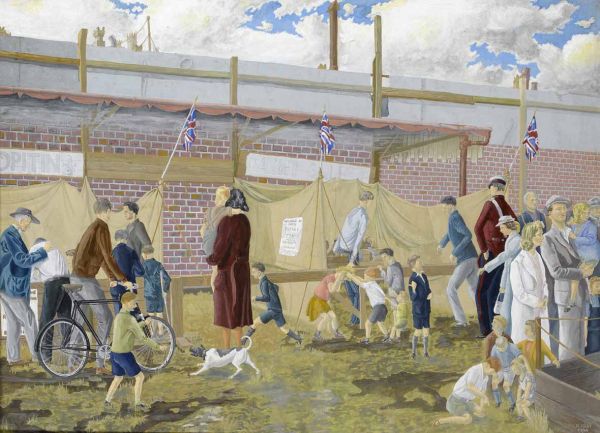
Wartime Fete, 1943
Framed (ref: 3549)
Signed and dated
Gouache
20 3/4 x 28 1/3 in. (52.7 x 72 cm)
Tags: Josh Kirby gouache children leisure sport war World War II Paintings by British Artists

Signed and dated
Gouache
20 3/4 x 28 1/3 in. (52.7 x 72 cm)
Tags: Josh Kirby gouache children leisure sport war World War II Paintings by British Artists
Literature: WW2 - War Pictures by British Artists, Edited by Sacha Llewellyn & Paul Liss, July 2016, cat 98, page 144-145.
Kirby studied art at the Liverpool City Society of Art in 1943 and in the same year was evacuated to South Wales to avoid the heavy bombing of his native city. He was 15 years old when he painted this remarkable image of a local fete - a scene that almost succeeds in disguising the fact that Britain was at war.
A notice pinned to the canvas of the Aunt Sally stall mentions the
Rotary Fair. Rotary International was precisely at that time beginning to expand its mission to promote peace and international understanding through educational and cultural exchanges: an important London Rotary conference was held in 1943, attended by ministers of education and observers from around the world and inspiring the
establishment of UNESCO after the war, in 1946.
The scene is peopled by civilians enjoying themselves: large numbers of children, parents and older folk. There appear to be a few men of service age dressed in ‘civvies’: some of the youths manning the stalls may have been travelling fairground people, or possibly slightly too young for conscription, while male punters could, for example, be miners or other workers in other reserved occupations. The figure in a blue and scarlet uniform is probably a civilian brass bandsman wearing a quasi-military uniform.
With few exceptions, dress is semi-smart or casual and relatively plain, as was common during wartime when rationing dictated the amount of new clothing that civilians could purchase and many had to make do with old garments, repairing and re-modelling garments where possible. Even dyes for fabric were restricted to a range of basic colours, which could partly account for the slightly limited colour palette. Lively, down-to-earth and reassuringly ordinary, despite the extraordinary circumstances of the time, this
closely-observed scene must have offered a reprieve from the reality of war in 1943,
while to the modern viewer it conveys a wonderful sense of nostalgia.
We are grateful to Jayne Shrimpton and John Mills for assistance.